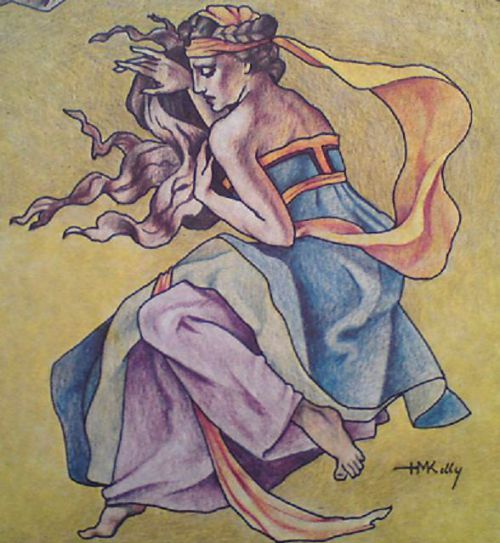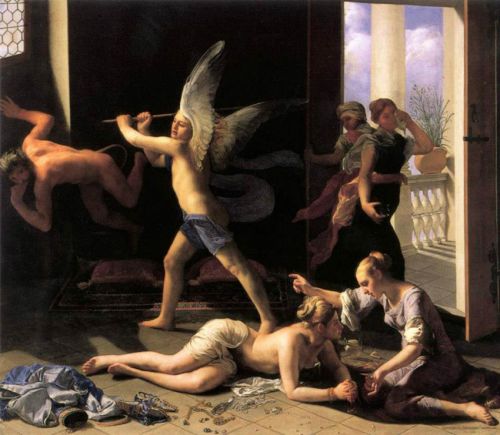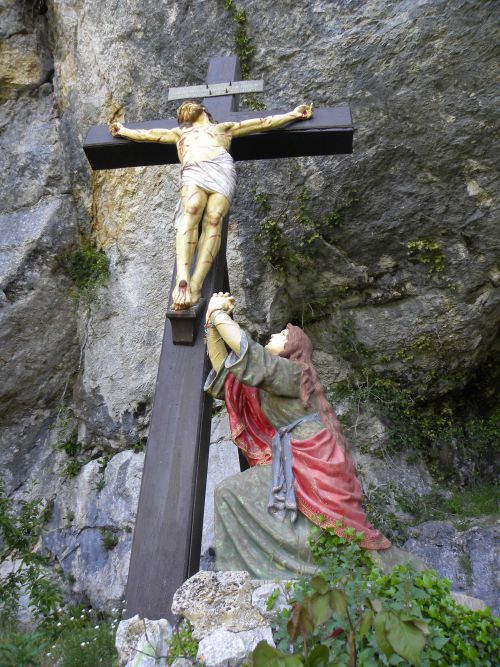Mary Magdalene Music
As Mary Magdalene grows more popular, many people are making films and writing songs about her. With Google's help, these come through to me every day and it's worth sharing them with you because of the insight they give into the ideas of others about Mary Magdalene. And some are quite moving.
"Goddess of the Gospels" is vaguely erotic - a blonde lady goes into a church to find the Goddess, who has beautiful long red hair - a sign of royalty. The song is quite haunting . . . click here.
And here's a film based around a song, quite religious, a real tear-jerker - there's a lot of people out there thinking about Mary Magdalene. Click here.
And if you too have a favourite song or piece of music, tell us about it.
Something Unusual that uncovered little known history.
This is about an opera written in the late 19th century, a story which came to light quite by accident when my friend Olivier, who lives in Marseille, sent me a picture of Mary Magdalene dancing.
It seemed to me from the style, to have been done in the 1920's, so I asked Olivier if he knew the picture's history. "I think it was used to promote a musical of someone called Jules Massenet." Later I found there is a street and a college named after Massenet in Marseille.
In Wikipedia where I researched, there was Massenet's name and a picture of him. As soon as I saw his picture, I thought, what a spiritual looking man.
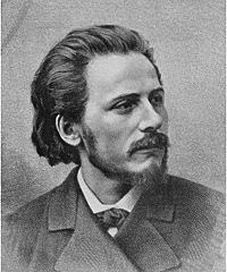
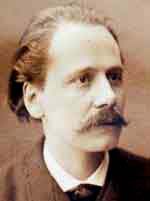
Jules Émile Frédéric Massenet (May 12, 1842 – August 13, 1912) was a French composer best known for his operas. His compositions were popular in the late 19th and early 20th centuries, and he ranks as one of the greatest melodists of his era. (That is, his tunes and songs were very singable.) Soon after his death in 1912, his style went out of fashion. Apart from Manon and Werther, his works were rarely performed. However, since the mid-1970s, many operas of his such as Thaïs and Esclarmonde have undergone revivals.
Massenet was born in the Loire, but when he was six, his family moved to Paris due to his father's ill-health. There his mother Adélaïde started taking piano pupils. She also taught Jules so well that at the age of 11 he was able to enter the Paris Conservatoire. He was still a student when his family moved from Paris to Chambéry, but Jules returned to Paris after a few months, living with a relative. To support himself during his studies, he worked as timpanist for six years at the Théâtre Lyrique, playing also other percussion instruments in other theatres, and working as a pianist in the Café de Belleville.
Although at first some of his teachers had not predicted for him any career in music, this changed in 1862 when he won the Grand Prix de Rome with his cantata David Rizzio and spent three years in Rome. There he met Franz Liszt, at whose request he gave piano lessons to Louise-Constance "Ninon" de Gressy, from a wealthy family. She became Massenet's wife in 1866. Their daughter Juliette was born in 1868.
Massenet's second work, his dramatic oratorio Marie-Magdeleine (first performed in 1873) sealed his career and won him praise, especially from Tchaikovsky in 1880. Tchaikovsky wrote three letters in which he described the great impression that Massenet's oratorio Marie-Magdeleine had made on him. He was deeply moved by the duet between Jesus and Mary Magdalene. (The spelling of "magdeleine" was correct then; it latter evolved to "madeleine.")
Massenet's real mentor was the composer Ambroise Thomas, a man with important contacts in the theatrical world. Another important early patron was his publisher, Georges Hartmann, whose connections with journalistic circles aided him in becoming better known during the difficult initial years of his composing activity.
In 1876 he received the Légion d'honneur, and was appointed a Grand Officer in 1899. In 1878 he was elected a member of the Académie des Beaux-Arts, to the exclusion of Camille Saint-Saëns. He was only 36, the youngest member ever elected to the Académie.
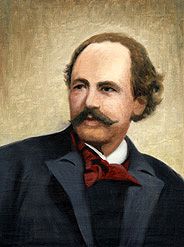 The successful Massenet
The successful Massenet
In addition to his operas, Massenet composed concert suites, ballet music, oratorios and cantatas and about two hundred songs. Some of his non-vocal output has achieved widespread popularity, and is commonly performed: for example the Méditation from Thaïs, which is a violin solo with orchestra, (you can find it on YouTube) as well as the Aragonaise, from his opera Le Cid and the Élégie for cello and orchestra (from his incidental music to Les Érinnyes). The latter two pieces are commonly played by piano students, and the Élégie became world-famous in many arrangements.
Being a very prolific, hard-working composer he created his pieces not "at the piano" (as so many other composers do) but entirely from his imagination. That ability greatly helped him to achieve his high standards as an orchestrator. He was also known to avoid all public dress rehearsals and performances of his works; often he would have to be informed by others of his own successes.
His Oratorios and cantatas included; David Rizzio in 1863, Marie-Magdeleine in 1873, Ève in 1875, Narcisse in 1877, La Vierge in 1880, Biblis in 1886, La Terre Promise in 1900.
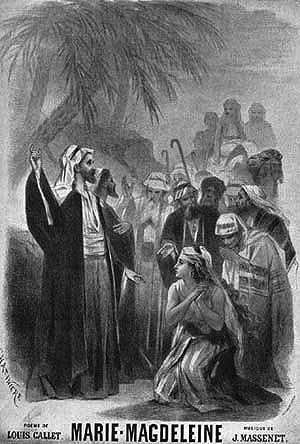 "Marie-Magdeleine" is an oratorio (or Sacred Drama) in four acts by Jules Massenet to a French libretto by Louis Gallet, influenced, it's said, by La vie de Jésus (1863) by Ernest Renan. One critic said; "The down-to-earth realism of Marie Magdeleine is akin to the controversial realistic approach of Ernest Renan's Life of Jesus."
"Marie-Magdeleine" is an oratorio (or Sacred Drama) in four acts by Jules Massenet to a French libretto by Louis Gallet, influenced, it's said, by La vie de Jésus (1863) by Ernest Renan. One critic said; "The down-to-earth realism of Marie Magdeleine is akin to the controversial realistic approach of Ernest Renan's Life of Jesus."
The first performance was at the Théâtre de l'Odéon in Paris on Good Friday, April 11, 1873. (Bérenger Saunière's 21st birthday.) The famous mezzo-soprano Pauline Viardot played the title role. It was Massenet's first success and was repeated throughout his lifetime, sometimes as a stage play, in places like Nice, Brussels and Naples.
Mary's sister Martha tries to persuade her to give up her life of sin, while an angel chases away her demons.
The subject of a woman of ill-repute whose life was reformed by love was attractive to a Parisian public, who had fallen in love with the idea after the play La Belle Dame aux Camelias by Alexander Dumas (fils), which ran for 50 years from 1852 (the year of Bérenger Saunière's birth.)
The story of "Marie-Magdeleine" concerns the last days of Jesus from the perspective of Mary Magdalene. The subject initially caused some controversy, as some believed that physical love was implied between Jesus and Mary Magdalene. The Principal characters were Marie-Magdeleine called Méryem (amazing, Mary M, no less!) - soprano, Marthe - mezzo-soprano, Jésus - tenor and Judas - bass.
Massenet labeled Marie-Magdeleine a drame sacré (sacred drama) which tells the story of the meeting between the courtesan Méryem and Jesus Christ.
Act 1 takes place in the evening at the well on the outskirts of Magdala, Mary M's home town. There the prostitutes gathered to await partners but "the handsome young Jesus" came to speak to them. Méryem repented even though her friends mocked them both.
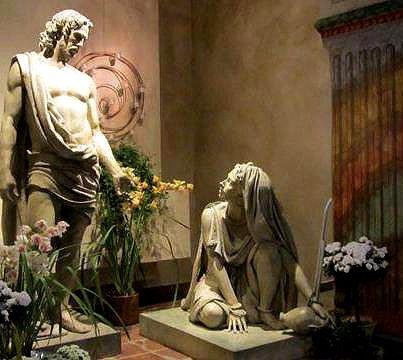 A representation of the first meeting between Jesus and Mary Magdalene
A representation of the first meeting between Jesus and Mary Magdalene
In Act 2 Jesus visits her at her home. Her servants start to organise flowers, perfumes and music but they are told not to, for the expected visitor is not as other men. Jesus arrives and brings the other disciples, including Judas, foreshadowing his betrayal of Christ. Jesus admires her repentance, they all pray together, and then Méryem and Jesus sing a duet together.
The third act begins at Golgotha with the heroine grieving at the cross of Jesus. The crowd taunts him and Méryem sees him die.
Then, at the tomb, Jesus arrives and tells Méryem and the disciples to spread the news of the resurrection. A cloud of smoke appears - and Jesus disappears. The show ends with everyone rejoicing in song. A critic said; "Gallet and Massenet have captured the oriental colour in a thousand aspects."
The work features some exquisitely beautiful music, much of it of a reflective nature. The chorus sings frequently, often portraying specific groups such as the Pharisees and the Disciples. Though performed as both a concert and a staged piece, the work was generally felt to be more successful as an oratorio than as an opera. "Marie-Magdeleine" was noted in its day for its sincere and dramatic portrayal of events from the New Testament.
I loved what a French critic told me about this play;
In the original form of the oratorio, without sumptuous expenses, the work had not lost a captivating sensuality more than 130 years after its creation and reveals the same sumptuous unexpected treasure. Down the passage of the years, Marie Magdeleine had become a symbol of femininity, which one constantly finds associated with Christian iconography. Without doubt, the step of repentance by the sinner is bewitching as she leaves her life as a courtesan to become the companion of Jesus. Seductive and voluptuous, her amorous passion joins her with Christ and gives meaning to the evangelistic words. Louis Gallet has inspired all the principal players, but Mary Magdalene becomes an enigmatic creature, the prostitute and the saint, and in her, all women will recognise the mixture of sacred and profane love. (I note he doesn't say that men will recognise this too!) The work belongs to Massenet, with its dramatic style, its harmonious sensuality evoking the very human emotions of Méreyem, the serenity of Jesus, the derision of Judas, all in an oriental atmosphere.
The tenor playing Jesus, Patrick Garayt, has a seductive voice; Méryem tells him his words "wither away the sins of others." In the duo between Jesus and Méryem, they agree that true repentance refreshes the soul, even though the heart trembles with the goodness of God.
This work is unique, moving and dramatic.
Was it really influenced by Ernest Renan? I'm not sure. He was a French theologian and historian born in 1823. He enrolled in the seminary of St. Sulpice but in 1845 he renounced his calling, having been led by Germanic biblical scholarship to question the literal truth of Christian teaching. So in 1860, he visited the Holy Land Three years later, in 1863, he published La Vie de Jésus, translated to English in 1864. The book portrayed Jesus as mortal and not divine. He stated his new religious values, what would be called today "secular humanism". But that wasn't what the public loved about Massenet's work - it was the passion in every sense.
Renan was no sensationalist, he was one of the most esteemed figures of his age. His book created one of the greatest controversies of 19th century religious thought. The book was a best-seller of the 19th century, among the top six books, and has never subsequently been out of print. For thirty years Renan remained a thorn in the Church's side publishing subsequent works on the Apostles, on Paul, and on early Christianity (that is, early Constantine Christianity.)
The Roman Church at the time was also reeling from the works of Charles Darwin, who questioned the Bible accounts of the creation in The Descent of Man (1871), and the agnostic philosophers of the day. Prussia was victorious over France in 1872. Well, it was a Christian country wasn't it? Yes, but Lutheran. The resulting German Empire was, for the first time since Charlemagne, a supreme military power NOT under Rome's control. The Church's response? Pope Pius IX devised the dogma of Papal Infallibility!
The Church started training priests as archeologists. One of them, Father Vaux, later tried to prevent the publication of the Dead Sea Scrolls. It took people like Michael Baigent and the Californian Eisenmann, both of whom have written about Rennes-le-Château, some 40 years to get them released. The Church trained intellectually élite priests and philosophers to protect and propound the teachings of the Church. This became known as the Catholic Modernist Movement.
Its members were intended to use the precision of German methodology to support scripture, not disprove it. They had to defend the literal truth of scripture with up-to-date research and scholarship. Of course, faith cannot be proved by logic and so this movement failed magnificently. The Modernists questioned what they were defending. One of the most prominent, Alfred Loisy, said basic dogma such as the Virgin Birth and Jesus's divinity were not longer tenable.
The Popes (now infallible!) had to take steps. In 1902, Leo VIII created a commission to control scriptural scholarship, then Puis X opposed all scholarship which questioned the origins of Christianity. The Inquisition (which still exists) started banning books like those by Renan and Loisy. All Catholic teachers suspected of Modernist tendencies were dismissed. Student priests in seminaries were forbidden to read newspapers!
Today these things all seem rather silly. Few believe the Bible literally; we understand they did not know so much science then. But the symbolic and spiritual truths of human nature, and the need for religious beliefs, remain eternal.
And we understand the love of Mary Magdalene.
For all musicians - I have a pdf of the music score for "Marie-Magdeleine." Send me a message with your e-mail address at the "Contacter Auteur" box below, and I will send you one. Suitable for piano or guitar. No charge.
Inscrivez-vous au site
Soyez prévenu par email des prochaines mises à jour
Rejoignez les 261 autres membres

